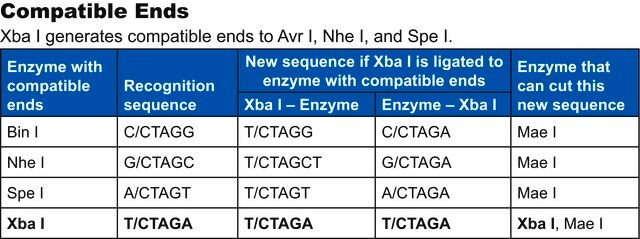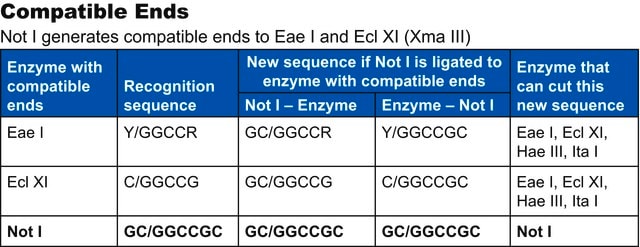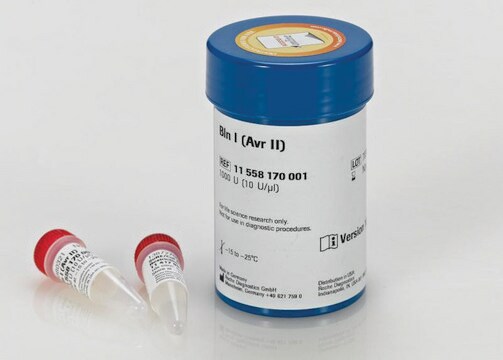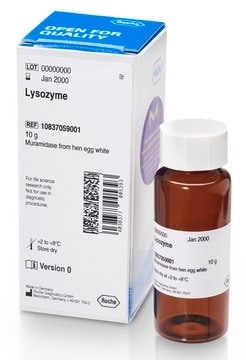Kluczowe dokumenty
SPEI-RO
Roche
Spe I
from Sphaerotilus species
Synonim(y):
Spe I, SPE I
About This Item
Polecane produkty
pochodzenie biologiczne
bacterial (Sphaerotilus spp.)
Poziom jakości
Postać
solution
aktywność właściwa
10000 U/mL
opakowanie
pkg of 1,000 U (11008951001 [10 U/μl])
pkg of 1,000 U (11207644001 [40 U/μl])
pkg of 200 U (11008943001 [10 U/μl])
producent / nazwa handlowa
Roche
Parametry
37 °C optimum reaction temp.
kolor
colorless
pH
8.0 (39 °F)
rozpuszczalność
water: miscible
przydatność
suitable for molecular biology
Zastosowanie
life science and biopharma
sample preparation
obecność zanieczyszczeń
Endonucleases 10 units, none detected
Warunki transportu
dry ice
temp. przechowywania
−20°C
Powiązane kategorie
Opis ogólny
Specyficzność
*A*CTAGT
Restriction site: *A↓*CTAGT
*A↓*CTAGT
Heat inactivation: Spe I can be heat inactivated by incubation at 65 °C for 15 minutes (up to 100 U/μg DNA).
Jakość
1μg Ad2 DNA is incubated for 16 hours in 50μl SuRE/Cut Buffer H with an excess of Spe I. The number of enzyme units which do not change the enzyme-specific pattern is stated in the certificate of analysis.
Absence of exonuclease activity
Approximately 5μg [3H] labeled calf thymus DNA are incubated with 3μl Spe I for 4 hours at +37°C in a total volume of 100μl 50mM Tris-HCl, 10mM MgCl2, 1mM Dithioerythritol, pH approximately 7.5. Under these conditions, no release of radioactivity is detectable, as stated in the certificate of analysis.
Profil DNA
- λ: 0
- φX174: 0
- Ad2: 3
- M13mp7: 0
- pBR322: 0
- pBR328: 0
- pUC18: 0
- SV40: 0
Definicja jednostki
Przechowywanie i stabilność
Komentarz do analizy
Spe I ends are compatible with ends generated by Bln I, Nhe I, and Xba I.
Isoschizomers
The enzyme is an isoschizomer of Bcu I and Ahl I.
Methylation sensitivity
As indicated by (*) on the recognition sequence above, Spe I is inhibited by the presence of N6-methyladenine and 5′-methylcytosine ( mA↓m CTAGT).
Incubation temperature
+37°C
PFGE tested
Spe I has been tested in Pulsed-Field Gel Electrophoresis (on bacterial chromosomes). For cleavage of genomic DNA (E. coli C 600) embedded in agarose for PFGE analysis, we recommend using 10U of enzyme/μg DNA and 4 hour incubation time.
Ligation and recutting assay
Spe I fragments obtained by complete digestion of 1μg Ad2 DNA are ligated with 1U T4 DNA Ligase in a volume of 10μl by incubation for 16 hours at +4°C in 66mM Tris-HCl, 5mM MgCl2, 5mM Dithiothreitol, 1mM ATP, pH 7.5 (at +20°C), resulting in >90% recovery of Ad2 DNA.
Subsequent re-cutting with Spe I yields >95% of the typical pattern of Ad2 × Spe I fragments.
The buffer in bold is recommended for optimal activity
- A: 75-100%
- B: 75-100%
- H: 100%
- L: 75-100%
- M: 100%
Inne uwagi
Tylko elementy zestawu
- Enzyme Solution
- SuRE/Cut Buffer H 10x concentrated
Kod klasy składowania
12 - Non Combustible Liquids
Klasa zagrożenia wodnego (WGK)
WGK 1
Temperatura zapłonu (°F)
does not flash
Temperatura zapłonu (°C)
does not flash
Certyfikaty analizy (CoA)
Poszukaj Certyfikaty analizy (CoA), wpisując numer partii/serii produktów. Numery serii i partii można znaleźć na etykiecie produktu po słowach „seria” lub „partia”.
Masz już ten produkt?
Dokumenty związane z niedawno zakupionymi produktami zostały zamieszczone w Bibliotece dokumentów.
Produkty
Termin "enzym restrykcyjny" wywodzi się z badań nad fagiem λ (fagiem lambda) Enterobacteria w laboratoriach Wernera Arbera i Matthew Meselsona.
The term “Restriction enzyme” originated from the studies of Enterobacteria phage λ (lambda phage) in the laboratories of Werner Arber and Matthew Meselson.
Nasz zespół naukowców ma doświadczenie we wszystkich obszarach badań, w tym w naukach przyrodniczych, materiałoznawstwie, syntezie chemicznej, chromatografii, analityce i wielu innych dziedzinach.
Skontaktuj się z zespołem ds. pomocy technicznej






